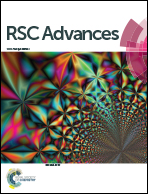Design, synthesis and characterization of near-infrared long persistent phosphors Ca4(PO4)2O:Eu2+,R3+ (R = Lu, La, Gd, Ce, Tm, Y)
Abstract
Near-infrared (NIR) persistent phosphors have many remarkable optical advantages in bioimaging applications. However, only a very few activators and hosts have been found to exhibit NIR persistent luminescence. Here, we report Eu2+-activated phosphate NIR long persistent phosphors, Ca4(PO4)2O:Eu2+,R3+ (R = Lu, La, Gd, Ce, Tm, Y). All the codoped samples showed persistent luminescence peaking at a long wavelength of ca. 690 nm due to the 5d–4f transitions of Eu2+. The persistent luminescence of Ca3.97(PO4)2O:Eu0.012+,Y0.023+ can be detected for 2 h after the removal of excitation. As a key parameter of persistent phosphors, the trap depths can be tuned from 0.62 to 0.77 eV by codoping with trivalent rare earth ions. The I−1–t curves reveal that two effective traps contribute to long persistent luminescence of Y3+, Tm3+ and Ce3+ codoped samples, whereas there is only one effective trap for La3+, Gd3+ and Lu3+ codoped samples, which was confirmed by the thermoluminescence curves of the codoped samples. This investigation provided a new long persistent phosphor which enriches the activator and hosts of existing NIR long persistent phosphors for potential application in vivo bioimaging.


 Please wait while we load your content...
Please wait while we load your content...